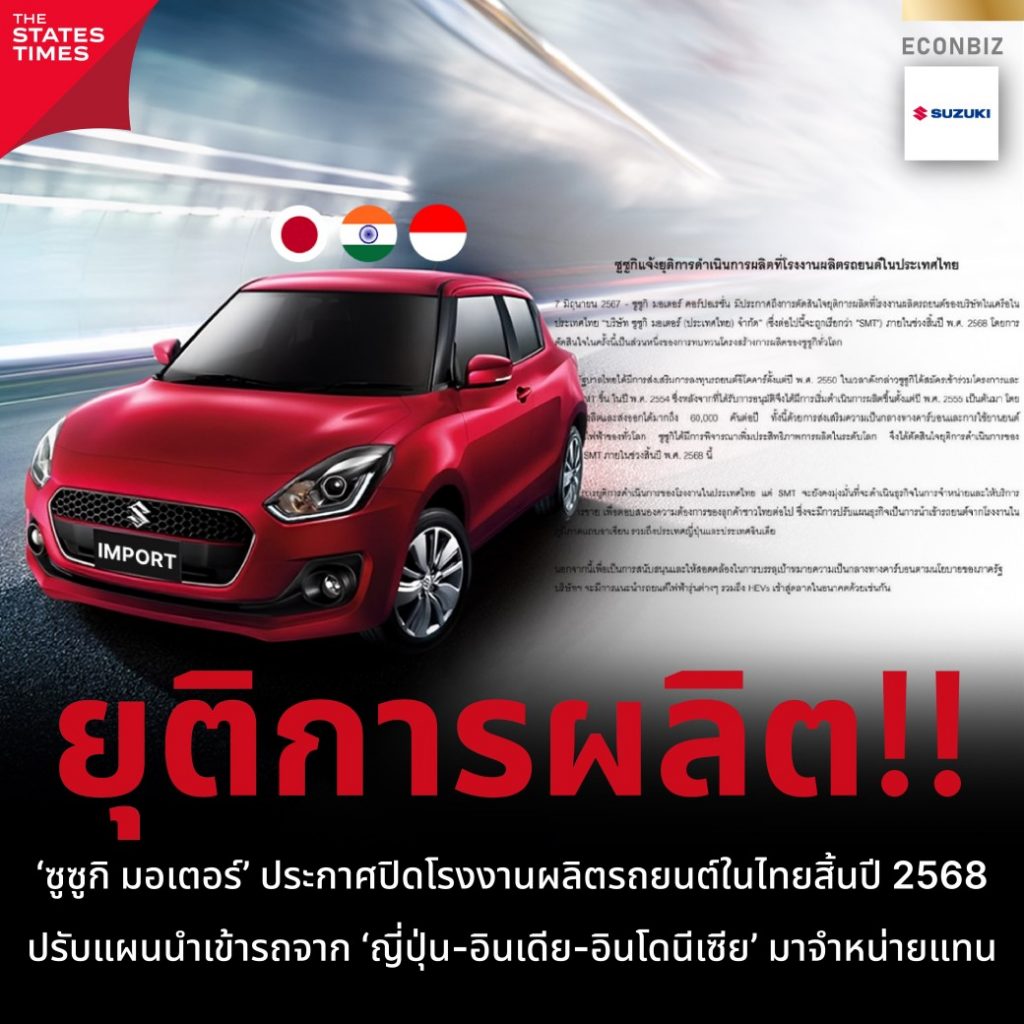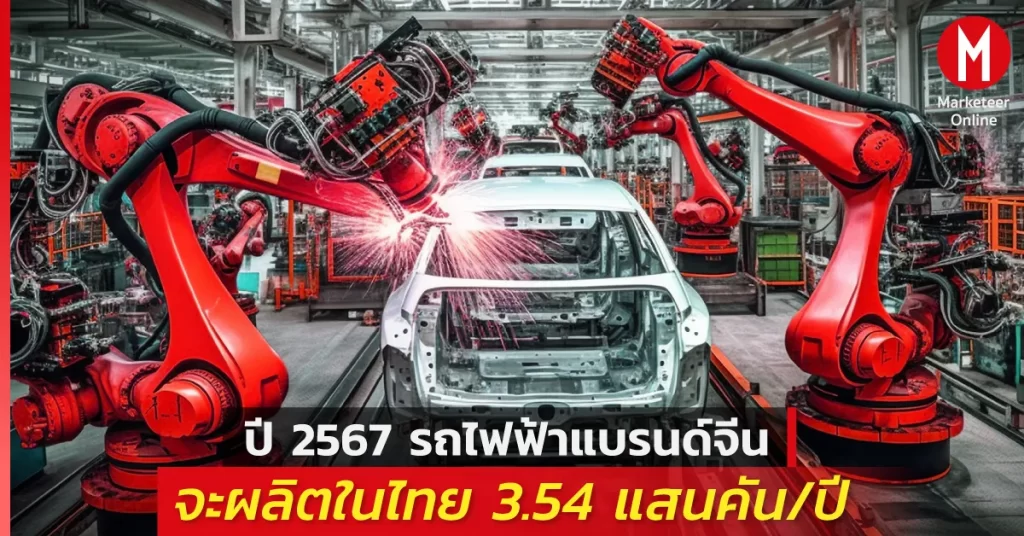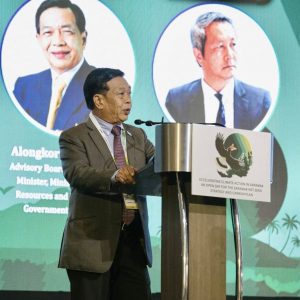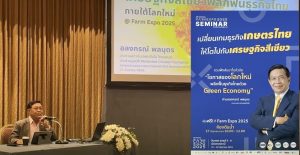
บริษัทรถยนต์ญี่ปุ่น 2 แห่ง ประกาศหยุดสายการผลิตรถยนต์ในไทยภายในปี 2567
อุตสาหกรรมยานยนต์ในไทยกำลังถึงจุดเปลี่ยนสำคัญ โดยมีปัจจัยสำคัญจากรถยนต์ไฟฟ้า (อีวี) ที่เข้ามาทำตลาดในไทย และยอดขายเติบโตต่อเนื่อง ในขณะที่ตลาดในประเทศได้รับแรงกดดันจากปัญหาหนี้ครัวเรือน สินเชื่อรถไม่ได้รับการอนุมัติ และเศรษฐกิจที่ไม่ฟื้นตัว ในช่วง 1 เดือน ที่ผ่านมา บริษัทรถยนต์ญี่ปุ่น 2 แห่ง ประกาศหยุดสายการผลิตรถยนต์ในไทย โดย บริษัท ซูซูกิ มอเตอร์ (ประเทศไทย) จำกัด ประกาศปิดโรงงานภายในสิ้นปี 2568 เพราะมีปัญหายอดขาย และการเข้ามาทำตลาดของอีวีจีน
ทั้งนี้ หากย้อนกลับไปดูผลดำเนินงานของบริษัท ซูซูกิ มอเตอร์ (ประเทศไทย) จำกัด ในช่วง 5 ปี ที่ผ่านมา (2562-2566) มีเพียงปี 2564 ที่มีผลดำเนินงานกำไร 131 ล้านบาท ขณะที่ผลดำเนินล่าสุดปี 2566 รายได้รวม 7,037 ล้านบาท รายจ่ายรวม 7,301 ล้านบาท และขาดทุน 264 ล้านบาท
ขณะที่บริษัท ตันจง ซูบารุ ออโตโมทีฟ (ประเทศไทย) จำกัด ประกาศหยุดการผลิตรถยนต์ในไทยภายในปี 2567 โดยจดทะเบียนธุรกิจในปี 2559 และผลดำเนินงานในช่วง 5 ปี ที่ผ่านมา (2561-2565) ขาดทุนต่อเนื่องทุกปี และนับได้ว่าตั้งแต่จดทะเบียนมีผลดำเนินงานขาดทุนทุกปี โดยในปี 2565 รายได้รวม 2,077 ล้านบาท รายจ่ายรวม 2,453 ล้านบาท ขาดทุน 377 ล้านบาท
นอกจากนี้ ในช่วงระยะเวลา 5 ปี จะมีค่ายรถยนต์จากประเทศญี่ปุ่นขยายการลงทุนเพิ่มเติมในประเทศไทยประมาณ 1.5 แสนล้านบาท ประกอบด้วย โตโยต้า 5 หมื่นล้านบาท , ฮอนด้า 5 หมื่นล้านบาท, อีซูซุ 3 หมื่นล้านบาท และมิตซูบิชิ 2 หมื่นล้านบาท
แหล่งข่าววงการยานยนต์ ระบุว่า การประกาศหยุดการผลิตของซูบารุ และซูซูกิ เชื่อว่าไม่ได้เพิ่งตัดสินใจ แต่ผ่านกระบวนการคิดมานานแล้ว รวมถึงมีการวางแผนจัดการด้านทรัพย์สินของโรงงาน ก่อนจะประกาศเป็นทางการ ทั้งนี้ มองว่าการเปลี่ยนแปลงเกิดขึ้นจากหลายปัจจัยประกอบกัน ทั้งการแข่งขัน ภาวะตลาด รวมถึงการส่งออกที่เป็นสิ่งสำคัญของอุตสาหกรรมยานยนต์ไทยที่มีตลาดส่งออกมากกว่า 100 ประเทศ และมีขนาดตลาดใหญ่กว่าในประเทศ แต่ที่ผ่านมาตลาดส่งออกซูซูกิไม่ดีได้นัก เพราะตลาดเป้าหมายหดตัว โดยปี 2566 ซูซูกิมียอดส่งออกแค่ 1,272 คัน ถือว่าน้อยมาก รวมทั้งเมื่อรวมกับผลกระทบจากอีวี และที่สำคัญคือ การที่รัฐจะยกเลิกการส่งเสริม อีโค คาร์ ที่เป็นผลิตภัณฑ์หลักของซูซูกิ ในปี 2569 จึงเป็นฟางเส้นสุดท้ายที่ทำให้ตัดสินใจหยุดผลิตตั้งแต่ปี 2569 ขณะเดียวกันเครือข่ายการผลิตซูซูกิมีหลายแห่ง รวมถึงในอินโดนีเซียซึ่งสามารถทำตลาดในอาเซียนได้ด้วยเงื่อนไขเขตการค้าเสรีอาเซียนหรืออาฟตา ทำให้การรวมฐานการผลิตจะช่วยให้การบริหารจัดการต้นทุนดีขึ้น
การหยุดสายการผลิตของซูบารุและซูซูกิ ทำให้เกิดความตื่นตระหนกว่าจะลุกลามไปบริษัทอื่นหรือไม่ โดยเฉพาะรายเล็กที่มียอดขายไม่มากนัก อนาคตไม่มีใครฟันธงว่าจะเกิดการเปลี่ยนแปลงอะไรหรือไม่ แต่ระยะใกล้เชื่อว่าโรงงานต่างๆ ยังเดินหน้าการผลิตเพราะต้องรองรับตลาดส่งออกด้วย โดยมีบริษัทแม่เป็นผู้ควบคุมการบริหารจัดการ และสถานะของไทยยังมีความสำคัญกับตลาดโลก จากการมีความแข็งแกร่งของผู้ผลิตชิ้นส่วน ความแข็งแกร่งของทักษะแรงงาน
สำหรับทิศทางอุตสาหกรรมรถยนต์ในช่วงปี 2566-2568 มีแนวโน้มเติบโตต่อเนื่องจากปัจจัยหนุน ได้แก่ 1) ทิศทางการฟื้นตัวของเศรษฐกิจและการกระเตื้องขึ้นของกำลังซื้อท่ามกลางภาวะเงินเฟ้อที่น่าจะทยอยปรับลดลง 2) ปัญหาขาดแคลนชิปแม้จะยังคงมีอยู่เป็นระยะในปี 2566 ภายใต้แรงกดดันของสงครามเทคโนโลยีโดยเฉพาะสหรัฐฯ และจีน แต่คาดว่าจะคลี่คลายลงในช่วงปี 2567-2568 หลังจากอุปทานชิปเริ่มเข้าสู่ตลาดโลกมากขึ้นจากการเร่งลงทุนเพิ่มกำลังการผลิตชิปในหลายประเทศ เช่น สหรัฐฯ เยอรมนี และญี่ปุ่น 3) นโยบายอุดหนุนการใช้รถไฟฟ้าแบบแบตเตอรี่ (BEV) ที่ยังมีต่อเนื่อง 4) การเร่งลงทุนในโครงสร้างพื้นฐานหลายโครงการของภาครัฐ และการขยายตัวต่อเนื่องของธุรกิจค้าปลีกออนไลน์และโลจิสติกส์ ตลอดจนการฟื้นตัวของธุรกิจท่องเที่ยวหลังการเปิดประเทศมากขึ้น ช่วยหนุนความต้องการรถเพื่อการพาณิชย์ และ 5) ผู้ประกอบการมีแผนเปิดตัวรถยนต์รุ่นใหม่เพื่อกระตุ้นตลาดอย่างต่อเนื่อง โดยเฉพาะรถยนต์ไฟฟ้าตอบรับนโยบายอุดหนุนของภาครัฐ ส่วนการส่งออกคาดว่าในปี 2566 จะยังเติบโตในอัตราไม่สูงนักตามทิศทางกำลังซื้อของประเทศคู่ค้าที่ยังคงซบเซาก่อนที่จะกระเตื้องขึ้นในปี 2567-2568 ภายใต้ความเสี่ยงจากนโยบายลดการใช้รถยนต์เครื่องยนต์สันดาปภายใน (Internal Combustion Engine: ICE) ของหลายประเทศ ในขณะที่การส่งออกรถยนต์ของไทยส่วนใหญ่ยังเป็น ICE
(ขอขอบคุณบทวิเคราะห์ สำหรับทิศทางอุตสาหกรรมรถยนต์ในช่วงปี 2566-2568 By Wanna Yongpisanphob)
Two Japanese automobile companies announced the suspension of production lines in Thailand by 2024.



Thailand’s automotive industry is at a critical turning point with electric vehicles (EVs) entering Thailand and continuing sales growth. Meanwhile, the domestic market has been pressured by household debt, unapproved auto loans, and the economy has not recovered. Two Japanese automobile companies announced a halt to their production lines in Thailand by Suzuki. Motor (Thailand) Co., Ltd. announced the closure of the plant by the end of 2018 due to sales problems and market penetration of EV China.
Looking back on Suzuki Motor (Thailand) Co., Ltd.’s operating performance during the past five years (2019-2013) alone recorded a profit of 131 million baht. The latest operating performance in 2020 showed a total revenue of 7,037 million baht, a total expense of 7,301 million baht and a loss of 264 million baht.
Tanjong Subaru Automotive (Thailand) Co., Ltd. announced the suspension of production in Thailand by 2024, registered business in 2016, and its operating performance during the past five years (2018-202) has been in a continuous loss every year. In 2012, total revenue was 2,077 million baht, total expense was 2,453 million baht, and loss of 377 million baht.
In addition, Japanese carmakers have expanded their investment in Thailand by Bt150 billion, consisting of Bt50 billion Toyota, Bt50 billion Honda, Bt30 billion Isuzu and Bt20 billion Mitsubishi.
Subaru and Suzuki’s announcement of production stoppage is believed to have not been decided, but have long passed the process of thinking and planning the plant’s asset management before the announcement is official. The change is seen in a number of factors, including competition and market conditions. As well as exports to the Thai automotive industry, which have more than 100 export markets and are larger than domestic ones. However, the Suzuki export market has not been very good in the past due to a contraction in the target market. In 2023, Suzuki had only 1 export.272 cars are considered very small, including the impact of EVs. The government’s cancellation of the promotion of Suzuki’s main product in 2016 was the last straw to decide to stop production since 1986. At the same time, there are many Suzuki production networks, including Indonesia, which can market in ASEAN with ASEAN Free Trade Area (AFTA) conditions. As a result, the consolidation of production bases will help improve cost management.
The suspension of Subaru and Suzuki’s production lines has caused panic over whether it will spread to other companies, especially small ones with limited sales. The future is empty.flag a changeIn the near term, manufacturing plants are still in operation because they have to support the export market. The company is a management controller. Thailand’s position is also important in the global market due to the strength of manufacturers and the strength of labor skills.
For the automobile industry during 2020-2025, there will be continuous growth driven by
1) economic recovery and a gradual improvement in purchasing power amid inflation
2) the problem of chip shortages, although it will persist in 2020 under the pressure of technological warfare, especially the US and China, but will ease down in 2027-2558. This was mainly due to increased investment in several countries such as the US, Germany and Japan.
3) continuing BEV policies
4) accelerating investment in infrastructure projects by the government, and continuing expansion in online retail and logistics business. Moreover, the recovery of the tourism industry after the opening of the country helped support demand for commercial vehicles.
5) The company plans to launch new models to stimulate the market, especially electric vehicles in response to the government’s subsidy policy.
Exports are expected to grow moderately in 2020 in line with sluggish purchasing power of trading partners before improving next year. 2017-2025, under the policy of reducing the use of internal combustion engines (ICE) in many countries, while the majority of Thai car exports are ICE.
(Thank you for the analysis for the direction of the automobile industry during the years 2563-2568 By Wanna Yongpisanphob)









